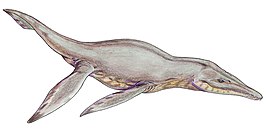Pliosaurus
| Pliosaurus | ||||||||||||
|---|---|---|---|---|---|---|---|---|---|---|---|---|

Pliosaurus in a live reconstruction |
||||||||||||
| Temporal occurrence | ||||||||||||
| Middle to Upper Jurassic ( Callovian to Kimmeridgian ) | ||||||||||||
| 166.1 to 152.1 million years | ||||||||||||
| Locations | ||||||||||||
|
||||||||||||
| Systematics | ||||||||||||
|
||||||||||||
| Scientific name | ||||||||||||
| Pliosaurus | ||||||||||||
| Owen , 1841 | ||||||||||||
Pliosaurus ( Gr .: pleion = more, sauros = lizard; to make it clear that the animal was more crocodile-like than Plesiosaurus ) is an extinct marine reptile from the group of plesiosaurs (Plesiosauria) from the Middle and Upper Jurassic.
Finds
The genus is already known in the 19th century due to some partially preserved skeletons. An almost complete skeleton of a 2.1 m long P. brachyspondylus was only found in 1994 by the fossil hunter Simon Carpenter in the southern English county of Wiltshire . Parts of an approximately 15 m large specimen were excavated in August 2007 by Jørn H. Hurum on Spitzbergen . An approx. 25 cm long tooth was known from Germany, which was described as P. giganteus .
description
Pliosaurus was a typical representative and the eponymous genus of the pliosaurs (Pliosauroidea), which differ from the actual plesiosaurs ( Plesiosauroidea ) by their short neck and long, pointed head . Pliosaurus was about 10 to 15 m long, its head length was 1.5 to 2.5 m. His eyes were large, the orbit reinforced with a ring of bone plates. The outer nostrils were very small, the same size as Rhomaleosaurus , which was only half the size of Pliosaurus . It is possible that the animal was breathing with its mouth when it surfaced. The outer nostrils were used for smelling underwater.
The jaws contained a total of 30 to 38 teeth, ten to twelve of which were on each branch of the lower jaw . The first five to six of these teeth were enlarged. Some authors do not distinguish Pliosaurus from Liopleurodon . The teeth of the latter were conical, round in cross section, those of Pliosaurus were triangular in cross section.
Currently this genus includes the two largest known pliosaurs, P. macromerus and P. funkei , which reached up to 15 m in length.
Way of life
Pliosaurus was likely an opportunistic hunter, hunting a wide range of prey, fish, cephalopods, and other marine reptiles, and using its eyes and smell to track its prey. It might also eat carcasses , like dinosaur carcasses in the sea. In a Pliosaurus fossil, three bone scales originally covered with a horny layer were found , which did not come from a Pliosaurus but were identified as the scales of an armored bird's pelvis dinosaur ( ankylosauria or stegosauria ). They may have been in the Pliosaurus's stomach .
species
The genus Pliosaurus includes the large Jurassic Pliosauridae with a triangular tooth profile. Numerous species have been described in the genus , the actual species belonging to which is doubtful because it was based on taxonomically unusable skeletal material such as vertebrae . Other fossils, mostly preserved in fragments, can be attributed to the genus, but their species membership cannot be determined or is in doubt. Today the following types are considered (possibly) valid
- Pliosaurus brachydeirus Owen , 1841 ( type species )
- Pliosaurus brachyspondylus (Owen, 1840)
- Pliosaurus macromerus ( Phillips , 1871)
- Pliosaurus funkei Knutsen, Druckermiller & Hurum, 2012 (Spitzbergen)
- Pliosaurus rossicus Novoshilov , 1948 (Russia)
- Pliosaurus kevani Benson et al. , 2013
- Pliosaurus westburyensis Benson et al., 2013
- Pliosaurus carpenteri Benson et al., 2013
Benson and colleagues also consider Pliosaurus brachyspondylus and Pliosaurus macromerus to be dubious species ( nomina dubia ), because the type of these species has been selected from vertebrae that cannot be used to diagnose the species.
literature
- Richard Ellis : Sea Dragons. Predators of the Prehistoric Oceans. University Press of Kansas, Lawrence KS 2003, ISBN 0-7006-1269-6 .
Web links
- Ben Creisler: Plesiosauria Translation and Pronunciation Guide Pliosaurus
Individual evidence
- ↑ Ben Creisler: Dinosauria Translation and Pronunciation Guide ( Memento of October 13, 2011 in the Internet Archive )
- ↑ http://www.polar-reisen.ch/downloads/monsterausspitzbergen.pdf
- ↑ https://www.youtube.com/watch?v=KAGNVG5Wz0M
- ↑ https://www.academia.edu/11482633/Belege_f%C3%BCr_riesige_Pliosaurier_aus_dem_Jura_Deutschlands
- ↑ Espen M. Knutsen (2013): A taxonomic revision of the genus Pliosaurus (Owen, 1841a) Owen, 1841b. Norwegian Journal of Geology Vol 92: 259-276.
- ^ Roger BJ Benson, Mark Evans, Adam S. Smith, Judyth Sassoon, Scott Moore-Faye, Hilary F. Ketchum, Richard Forrest (2013): A Giant Pliosaurid Skull from the Late Jurassic of England. PLoS ONE 8 (5): e65989. doi : 10.1371 / journal.pone.0065989